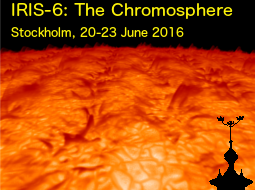Speaker
Yoshiaki Kato
(ITA, University of Oslo)
Description
A novel mechanism for generating longitudinal magneto-acoustic waves in a flux tube,
called magnetic pumping, has recently been studied as a robust mechanism for
generating chromospheric/coronal waves in strong magnetic elements (Kato et al.
2016). NASA's Interface Region Imaging Spectrograph (IRIS), covering
emission/absorption lines of the chromosphere and the transition region with an
imaging spectrograph as well as a slit-jaw imager, has opened a new window to
investigate the origin of such chromospheric/coronal waves that potentially energise
the solar atmosphere. In this study, we compute the vertically emergent intensity of
IRIS diagnostic lines, the Si IV and Mg II h&k, from a time series of snapshots of a
flux tube in a two-dimensional radiative MHD simulation with the Bifrost code. We
analyse the synthetic line profiles to detect the slow magneto-acoustic body wave
which becomes a shock in the lower chromospheric layers and propagates further into
the transition region. We find that the formation of the Mg II h&k lines is
associated with the propagating slow shocks. From the precise shape and Doppler
shifts of the k2v, k3 and k2r features in the Mg line profiles we can derive the
velocity amplitude of the shocks. By examining two options for measuring the phase
speed of the shocks, we will discuss feasible methods for estimating the energy flux
of shocks in magnetic elements by using IRIS observations.
Primary author
Yoshiaki Kato
(ITA, University of Oslo)

